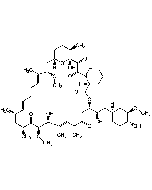Cookie Policy: This site uses cookies to improve your experience. You can find out more about our use of cookies in our Privacy Policy. By continuing to browse this site you agree to our use of cookies.
AdipoGen Life Sciences
FK-506
As low as
20
CHF
CHF 20.00
In stock
Only %1 left
AG-CN2-0047-M0011 mgCHF 20.00
AG-CN2-0047-M0055 mgCHF 35.00
AG-CN2-0047-M02525 mgCHF 140.00

| Product Details | |
|---|---|
| Synonyms | Tacrolimus; Fujimycin |
| Product Type | Chemical |
| Properties | |
| Formula |
C44H69NO12 . H2O |
| MW | 804.0 . 18.0 |
| Merck Index | 14: 9025 |
| CAS | 109581-93-3 |
| RTECS | KD4200000 |
| Source/Host Chemicals | Isolated from Streptomyces tsukubaensis. |
| Purity Chemicals | ≥98% (HPLC) |
| Appearance | White to off-white solid. |
| Solubility | Soluble in DMSO, ethanol, methanol, ethyl acetate or acetone. Insoluble in water. |
| Identity | Determined by 1H-NMR. |
| InChi Key | NWJQLQGQZSIBAF-CBLXODBSSA-N |
| Smiles | [H]O[H].[H][C@]1(CC[C@@]([H])(O)[C@@]([H])(C1)OC)\C=C(/C)[C@@]1([H])OC(=O)C2CCCCN2C(=O)C(=O)[C@]2(O)O[C@@]([H])([C@H](C[C@@]2([H])C)OC)[C@]([H])(C[C@@]([H])(C)C\C(C)=C\[C@@]([H])(CC=C)C(=O)CC(O)[C@@]1([H])C)OC |
| Shipping and Handling | |
| Shipping | AMBIENT |
| Short Term Storage | +4°C |
| Long Term Storage | -20°C |
| Handling Advice | Protect from light. |
| Use/Stability | Stable for at least 2 years after receipt when stored at -20°C. |
| Documents | |
| MSDS |
 Download PDF Download PDF |
| Product Specification Sheet | |
| Datasheet |
 Download PDF Download PDF |
Description
- Potent immunosuppressant (as cyclosporin A and rapamycin) [1-3].
- Suppresses proliferation of cytotoxic T cells and inhibits the production of T cell-derived mediators such as interleukin-2 (IL-2) [2, 4].
- Forms a complex with FK-506 binding protein 12 (FKBP12). Inhibits the activity of the calcium/calmodulin-dependent protein phosphatase 2B (PP2B; calcineurin), leading to disruption of T cell activation [2, 4, 6, 7].
- Prevents rejection of transplanted organs [3].
- Anti-inflammatory compound in the treatment of several inflammatory skin diseases (e.g. atopic dermatitis) and with potential anti-rheumatic activity (rheumatoid arthritis) [5, 9].
- Neuroprotective. Regulates nitric oxide neurotoxicity. Neurotransmitter. Ca2+ release compound [8].
- NF-κB suppressor by induction of unfolded protein response (UPR) [11].
- Anti-cancer compound. Apoptosis inducer [10, 12].
Product References
- FK-506, a novel immunosuppressant isolated from a Streptomyces. I. Fermentation, isolation, and physico-chemical and biological characteristics: T. Kino, et al.; J. Antibiot. (Tokyo) 40, 1249 (1987)
- Cyclosporin A, FK506 and rapamycin: more than just immunosuppression: J. Kunz & M.N. Hall; TIBS 18, 334 (1993)
- Cyclosporin A and FK506: molecular mechanisms of immunosuppression and probes for transplantation biology: B.E. Bierer, et al.; Curr. Opin. Immunol. 5, 763 (1993)
- The actions of cyclosporin A and FK506 on T-lymphocyte activation: P.S. Mattila; Biochem. Soc. Trans. 24, 45 (1996) (Review)
- FK506 in the treatment of inflammatory skin disease: promises and perspectives: G. Michel, et al.; Immunol. Today 17, 106 (1996) (Review)
- The mechanism of action of cyclosporin A and FK506: S. Ho, et al.; Clin. Immunol. Immunopathol. 80, S40 (1996) (Review)
- FK506, an immunosuppressant targeting calcineurin function: F.J. Dumont; Curr. Med. Chem. 7, 731 (2000) (Review)
- FK506 and its analogs - therapeutic potential for neurological disorders: A. Klettner & T. Herdegen; Curr. Drug Targets CNS Neurol. Disord. 2, 153 (2003) (Review)
- A review of the action of tacrolimus (FK506) on experimental models of rheumatoid arthritis: S. Miyata, et al.; Inflamm. Res. 54, 1 (2005) (Review)
- Metabolism of tacrolimus (FK506) and recent topics in clinical pharmacokinetics: K. Iwasaki; Drug Metab. Pharmacokinet. 22, 328 (2007) (Review)
- Suppression of NF-kappaB by cyclosporin A and tacrolimus (FK506) via induction of the C/EBP family: implication for unfolded protein response: S. Du, et al.; J. Immunol. 182, 7201 (2009)
- FK506 binding proteins as targets in anticancer therapy: S. Romano, et al.; Anticancer Agents Med. Chem. 10, 651 (2010) (Review)







